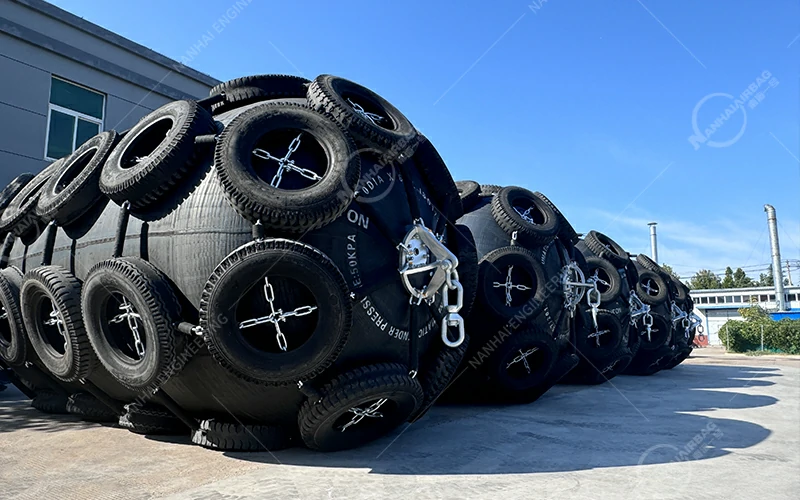How Marine Salvage Airbags and Floating Cranes Work Together to Recover a Sunken Ship
11/20/2025What Are the Advantages of Pneumatic Rubber Fenders Compared to Solid Rubber Fenders?
When you compare fender systems, one clear question appears: why do many large ships prefer pneumatic rubber fenders instead of solid rubber fenders?
The answer is simple — pneumatic fenders absorb more energy and give a softer, safer landing.
Below is a clean, practical comparison based on real berthing needs.

1. Higher Energy Absorption
Pneumatic fenders use compressed air to absorb impact.
When a ship presses on the fender, the air slowly compresses and spreads the force over time.
Solid rubber fenders cannot do this. Rubber has limited compression, so the energy absorption level is fixed.
This means:
- Pneumatic fenders absorb 3–4 times more energy
- Large ships get a much safer and smoother berthing
- Impact peaks become lower, reducing risk to hull and quay
That’s why VLCCs, LNG carriers, bulk carriers, and RoRo ships often choose pneumatic fenders.
2. Lower Reaction Force
While absorbing more energy, pneumatic fenders also create lower reaction force.
This is important because high reaction force can damage:
- hull plates
- coatings
- frames
- quay structures
Solid rubber becomes very stiff under compression. Its reaction force rises fast.
Pneumatic fenders stay softer because air compresses slowly.
This gives a gentle, controlled contact — especially useful during angled berthing.
3. Better Performance at Angled Berthing
Solid rubber fenders do not work well when the ship comes in at an angle.
The effective contact area becomes small, and the fender cannot deform enough.
Pneumatic fenders perform much better:
- They roll and match the ship’s curve
- They keep large contact area
- They maintain stable energy absorption
- They are ideal for STS operations
This is one of the biggest reasons offshore operators prefer pneumatic fenders.
4. Naturally Float and Handle Large Tidal Changes
Pneumatic fenders float on the water.
They automatically rise and fall with the tide.
Solid rubber fenders are fixed to the quay, so when the tide changes:
- They can be too high during low tide
- They can be too low during high tide
- The ship may not hit the correct spot
Pneumatic fenders solve this naturally without any extra structure.
This makes them perfect for deep-water ports and large tidal ranges.
5. Easy to Move, Deploy, and Store
Solid rubber fenders are heavy and must stay fixed on the quay.
Pneumatic fenders are much lighter and easy to move:
- You can lift or tow them
- You can deploy them at any berth
- You can move them between jobs
- You can deflate them to save space on deck
For temporary berths, shipyards, offshore operations, and emergency use, this flexibility is a huge advantage.
6. Adjustable Internal Pressure
Solid rubber fenders cannot change their performance.
Pneumatic fenders can:
- Lower pressure → softer contact for small ships
- Higher pressure → stronger performance for large ships
One set of pneumatic fenders can serve many different vessel sizes.
Summary Table
| Feature | Pneumatic Fenders | Solid Rubber Fenders |
|---|---|---|
| Energy absorption | Very high | Medium |
| Reaction force | Low | High |
| Angled berthing | Excellent | Limited |
| Tide changes | Self-adjusting | Fixed |
| Mobility | Easy to move | Very heavy |
| Best use | Large ships, STS, deep water | Fixed berths, small vessels |
Short conclusion:
Pneumatic fenders offer higher energy absorption, softer reaction force, better tidal performance, and more flexibility than solid rubber fenders.
FAQ
1. Are pneumatic fenders more expensive than solid rubber fenders?
The unit price may be higher, but you often need fewer units because of their higher energy absorption. For large ships, pneumatic fenders usually offer better value.
2. Can pneumatic fenders handle rough conditions?
Yes. Their floating design and flexible body help them stay stable even when the sea state changes.
3. Do pneumatic fenders need a lot of maintenance?
Not much. You mainly check the air pressure and inspect the body. This is simple and does not require heavy equipment.
4. Can one pneumatic fender cover different vessel sizes?
Yes. You can adjust the air pressure to match different ship types and berthing speeds.
{ “@context”: “https://schema.org”, “@type”: “FAQPage”, “mainEntity”: [ { “@type”: “Question”, “name”: “Are pneumatic fenders more expensive than solid rubber fenders?”, “acceptedAnswer”: { “@type”: “Answer”, “text”: “The unit price may be higher, but you often need fewer units because of their higher energy absorption. For large ships, pneumatic fenders usually offer better value.” } }, { “@type”: “Question”, “name”: “Can pneumatic fenders handle rough conditions?”, “acceptedAnswer”: { “@type”: “Answer”, “text”: “Yes. Their floating design and flexible body help them stay stable even when the sea state changes.” } }, { “@type”: “Question”, “name”: “Do pneumatic fenders need a lot of maintenance?”, “acceptedAnswer”: { “@type”: “Answer”, “text”: “Not much. You mainly check the air pressure and inspect the body. This is simple and does not require heavy equipment.” } }, { “@type”: “Question”, “name”: “Can one pneumatic fender cover different vessel sizes?”, “acceptedAnswer”: { “@type”: “Answer”, “text”: “Yes. You can adjust the air pressure to match different ship types and berthing speeds.” } } ] }